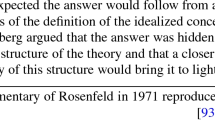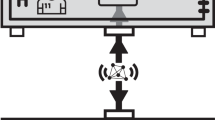Abstract
We propose a complete proof of the Born rule using an additional postulate stating that for a short enough time \(\Delta t\) between two measurements, a property of a particle will keep its values fixed. This dynamical postulate allows us to produce the Born rule in its explicit form by improving the result given in [1]. While the proposed postulate is still not part of the quantum mechanics postulates, every experiment obeys it, and it cannot be deduced using the standard postulates of quantum mechanics.
Similar content being viewed by others
Avoid common mistakes on your manuscript.
The Born rule is a postulate of quantum mechanics that provides the structure of the probability theory of quantum systems, and thus, it plays a key role in both theoretical and experimental studies of quantum systems. Over the years, several attempts have been made to prove, or at least trace, the mechanism behind the Born rule [1,2,3,4,5,6,7]. While we do not review recent results in the direction of proving the Born rule, we point out that a recent paper that reviews such a topic is given by Vaidman in [2]. In [1], the Born rule was proved by following an assumption about the stability of the system against small perturbations where it holds only for likely outcomes and is violated for unlikely outcomes, such as the case of a large coherent interference effect between the amplitudes of \(N>>1\) decoupled particles in the system. The proposed proof improves the one given in [1] by imposing a dynamical physical requirement that holds for every quantum system and for likely as well as unlikely outcomes. We start with a proof of the Born rule using only mathematical arguments, and then we show how an assumption that is made during the proof can be reformulated into a physical requirement about the dynamics of the quantum system.
Let \(\left| \psi \right\rangle =\sum _{j}b_{j}\left| a_{j}\right\rangle \) be a prepared state of a particle in the form of a superposition of non-degenerate eigenstates of some Hermitian operator A. Taking a sample of N identically prepared nonentangled particles in the state \(\left| \psi \right\rangle ,\) the state of this sample is given by the product state
We follow standard quantum theory where if A is measured on state \(\left| \psi \right\rangle \), the measurement outcomes are the eigenvalues \(\alpha _{j};\) however, their probabilities \(p_{j}\) are left unspecified, and the standard Born rule \(p_{j}=\left| b_{j}\right| ^{2}\) will be shown to uniquely follow from the proposed Postulate.
In [8], the authors proposed the following universal formula for A acting on \(\left| \psi \right\rangle ,\)
where \(\left| \psi _{\bot }\right\rangle \) is a state vector in the perpendicular Hilbert space that satisfies \(\left\langle \psi |\psi _{\bot }\right\rangle =0\), with the mathematical quantities
and
It is important to mention that both (3) and (4) do not have any statistical interpretation, and they are merely algebraic operations between A and \(\left| \psi \right\rangle .\) The formula (2) can be proved in various ways, algebraically or geometrically. A simple proof of (2) runs as follows: For an operator A acting on a vector state \(\left| \psi \right\rangle \), one can write \(A\left| \psi \right\rangle =c_{1}\left| \psi \right\rangle +c_{2}\left| \psi _{\bot }\right\rangle \) for some \(c_{1}\in {\mathbb {C}},c_{2}\ge 0\) (we can always choose such decomposition). Now, taking a ket state \(\left\langle \psi \right| \) on \(A\left| \psi \right\rangle ,\) we get \({\overline{A}}=c_{1},\) and applying \(\left\langle \psi \right| A\) on \(A\left| \psi \right\rangle \) yields \(\left\langle \psi \right| A^{2}\left| \psi \right\rangle =c_{1}^{*}c_{1}+c_{2}^{2}\), implying that \(c_{2}=\sqrt{\left\langle \psi \right| \left( A-{\overline{A}}\right) ^{2}\left| \psi \right\rangle }.\)
Without loss of generality, we consider the total operator acting on the sample by
Suppose that we wish to measure the sample of particles followed by the total operator \(A_{tot}.\) For a measuring device followed by the von-Neumann measurement, we have the following interaction Hamiltonian
for some coupling constant \(\lambda >0,\) where Q is conjugate to the pointer \(\Pi \) of the measuring device. We consider the evolution operator \(U=e^{-i\lambda QA_{tot}\Delta t}\) that acts on the coupled state \(\left| \Psi _{\text {total}}\right\rangle \left| \Pi \right\rangle \), where \(\left| \Pi \right\rangle \) is the pointer state of the measuring device. Following the formula (2), the evolution of \(\left| \Psi _{\text {total}}\right\rangle \) is given by the superposition of two orthogonal states
where \(\left| \Psi _{\bot \text {total}}\right\rangle =\sum _{r=1}^{N} {\displaystyle \prod \limits _{i\ne r}^{N}} \left| \psi \right\rangle _{i}\left| \psi _{\bot }\right\rangle _{r}\) is orthogonal to \(\left| \Psi _{\text {total}}\right\rangle .\) We note that the above equation can be proved in a similar way to (2) by plugging in \(\left\langle \Psi _{\text {total}}\right| \) from both sides of the equation to obtain the first part of the RHS, and then applying \(\left\langle \Psi _{\text {total}}\right| U\) to obtain the second part.
We define our time interval by \(\Delta t=\tau /N\) for some constant \(\tau >0.\) By expanding the exponential operator U with respect to \(\lambda ,\) we obtain
and
where \(\Delta A_{tot}^{2}=N\cdot \Delta A^{2}\) and thus, \(\Delta A_{tot}\) grows as \(\sqrt{N}.\) Then, for a sufficiently short time, \(\Delta t,\) the orthogonal state \(\Delta U\left| \Psi _{\bot \text {total}}\right\rangle \) is arbitrary small, and we get
which gives a shift in the pointer of the measuring device \(\left| \Pi \right\rangle \rightarrow \left| \Pi -\lambda \Delta tN{\overline{A}}\right\rangle ,\) so the observed value of \(\lambda A_{tot}\ \)after a short time \(\Delta t\) is \(\lambda N{\overline{A}}.\)
The outcome of our measurement, given our pointer \(\Pi \), cannot depend on the type of measurement we will do at a later time since, otherwise, we will break causality. Such measurements can be, for instance, measurements on the whole of the sample at once or measurements on each of the particles in the sample. Thus, we know for sure that no matter what type of measurement we will perform, we still will get a shift of the pointer by \(\lambda N{\overline{A}}.\) We note that the independence of the outcome concerns future measurements only on the system.
Suppose now that instead of applying \(A_{tot}\) on the sample state, we apply N projective measurements using the same pointer, each measurement with the underlying operator \(A_{i}\) for each of the particles in the sample. These measurements lead to the classical probability of outcomes \(p_{j}=N_{j}/N\), where \(N_{j}\) is the number of outcomes \(\alpha _{j}\) that has been detected in the microscopic measurements, and the average is clearly \(\sum _{j}p_{j} \cdot \alpha _{j}.\)
Following the fact that for sufficiently small \(\Delta t,\) \(e^{-i\lambda \overline{A_{tot}}\Delta tQ}\) describes the eigenvalue of U, for a post-selected state \(\left| post\right\rangle ,\) we find that the pointer will have the same shift, regardless of the type of post-selected measurements one will perform,
this shows that no matter what the post-selected state is, the pointer will have the same shift. From the consistency between the macroscopic measurement with the underlying sample state and the microscopic measurements, the result must yield the same value. We then obtain the following equality
with recalling that \(\left\langle \psi \right| A\left| \psi \right\rangle \equiv \sum _{j}\left( b_{j}^{*}b_{j}\right) \alpha _{j}.\) Dividing both sides by N, we have \(\sum _{j}\left( b_{j}^{*}b_{j}\right) \cdot \alpha _{j}=\sum _{j}p_{j}\cdot \alpha _{j},\) which holds, in general, if and only if
and we obtain the Born rule in its most explicit form.
While our proof was based purely on mathematical arguments and assumptions, it can be derived following an explicit physical requirement. We define a property \({\mathcal {P}}\) of a quantum system as a state in some observable. We conclude the paper by proposing the following additional Postulate to the Postulates of quantum mechanics:
Postulate. For a short enough time \(\Delta t\ \)between two measurements, a property, \({\mathcal {P}}\), of a particle, will keep its values fixed.
The above Postulate is consistent and in accordance with every standard experimental setup of quantum systems, and we can say that it is a physical principle of quantum systems. In fact, for a property \({\mathcal {P}}^{\prime }\) of a quantum system that does not satisfy the Postulate, we can say that \({\mathcal {P}}^{\prime }\) is not a property of the quantum system (for example, see [9]). The above Postulate allows us to prove the Born rule, as shown earlier in the paper, while rejecting other candidates that do not fulfill the proposed physical requirement. As a final remark, we note that following the physical requirement given in the proposed Postulate, our proof of the Born rule holds for both bounded and unbounded operators A with finite uncertainty \(\Delta A.\)
Data availability
No new data were generated or analysed during this study.
References
Aharonov, Y., Reznik, B.: How macroscopic properties dictate microscopic probabilities. Phys. Rev. A 65(5), 052116 (2002)
Vaidman, L.: Derivations of the Born Rule. Quantum, Probability, Logic, pp. 567–584 (2020)
Brumer, P., Gong, J.: Born rule in quantum and classical mechanics. Phys. Rev. A 73(5), 052109 (2006)
Buniy, R.V., Hsu, S.D., Zee, A.: Discreteness and the origin of probability in quantum mechanics. Phys. Lett. B 640(4), 219–223 (2006)
Zurek, W.H.: Entanglement symmetry, amplitudes, and probabilities: inverting Born’s rule. Phys. Rev. Lett. 106(25), 250402 (2011)
Brezhnev, Y.V.: The Born rule as a statistics of quantum micro-events. Proc. R. Soc. A 476(2244), 20200282 (2020)
Hemmo, M., Pitowsky, I.: Quantum probability and many worlds. Stud. Hist. Philos. Sci. Part B: Stud. Hist. Philos. Modern Phys. 38(2), 333–350 (2007)
Aharonov, Y., Vaidman, L.: Properties of a quantum system during the time interval between two measurements. Phys. Rev. A 41(1), 11 (1990)
An example of a violation of the Postulate. Consider the rectangle wavefunction \(\psi \left( x\right) =rect\left( x\right) \), which is a legitimate normalized wavefunction. Taking the free Hamiltonian \(p^{2}/2m,\) we see that the wavefunction is spreading almost immediately on the entire region of \(x\in {\mathbb{R}} .\) This type of a wavefunction does not follow the additional physical requirement
Funding
Open access funding provided by SCELC, Statewide California Electronic Library Consortium.
Author information
Authors and Affiliations
Corresponding author
Ethics declarations
Conflict of interest
The authors have no competing interests to declare that are relevant to the content of this article. Data sharing not applicable to this article as no datasets were generated or analyzed during the current study.
Additional information
Publisher's Note
Springer Nature remains neutral with regard to jurisdictional claims in published maps and institutional affiliations.
Rights and permissions
Open Access This article is licensed under a Creative Commons Attribution 4.0 International License, which permits use, sharing, adaptation, distribution and reproduction in any medium or format, as long as you give appropriate credit to the original author(s) and the source, provide a link to the Creative Commons licence, and indicate if changes were made. The images or other third party material in this article are included in the article’s Creative Commons licence, unless indicated otherwise in a credit line to the material. If material is not included in the article’s Creative Commons licence and your intended use is not permitted by statutory regulation or exceeds the permitted use, you will need to obtain permission directly from the copyright holder. To view a copy of this licence, visit http://creativecommons.org/licenses/by/4.0/.
About this article
Cite this article
Aharonov, Y., Shushi, T. Improving the proof of the Born rule using a physical requirement on the dynamics of quantum particles. Quantum Stud.: Math. Found. 11, 287–290 (2024). https://doi.org/10.1007/s40509-024-00322-x
Received:
Accepted:
Published:
Issue Date:
DOI: https://doi.org/10.1007/s40509-024-00322-x




